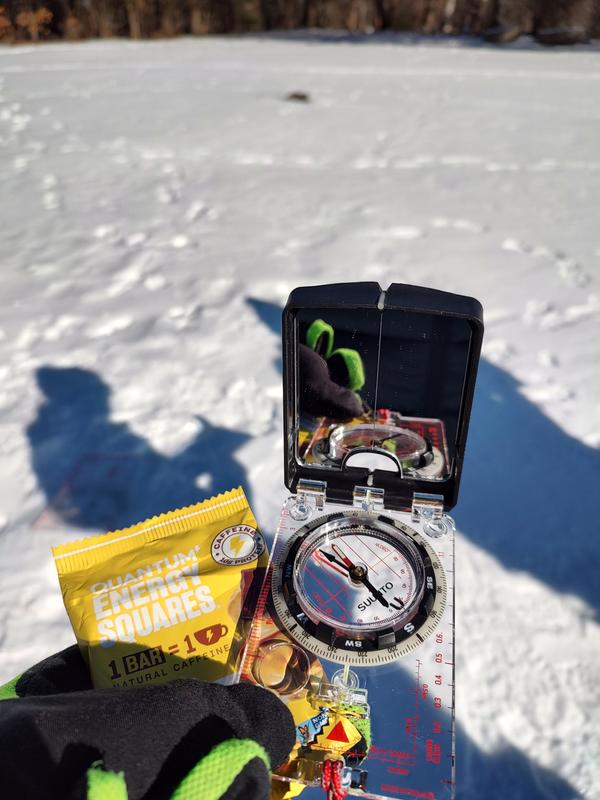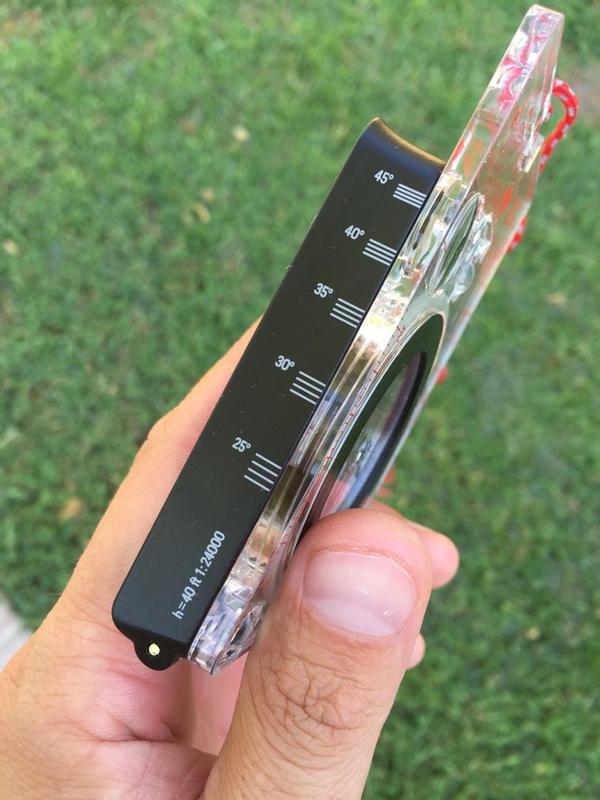Suunto MC-2 NH Mirror Compass
An accurate and reliable mirror compass for the outdoor enthusiast, the Suunto MC-2 NH mirror compass offers mirrored sighting, adjustable declination and a clinometer.
- Perfect for serious users, such as hikers, climbers and search-and-rescue personnel, the sighting mirror with V-notch allows you to take accurate bearings based on landmarks
- Sighting mirror folds down to protect compass
- Adjustable declination accounts for difference between true and magnetic north; lanyard key locks adjusted declination into place
- Balanced for use in the northern hemisphere
- Luminous, 2-color bezel ring, silicon map grippers on base, and meridian lines help orient compass to map
- Includes a clinometer to measure slope angles—useful to winter travelers to help estimate danger on avalanche-prone slopes
- Includes has an adjustable lanyard with snap lock and declination key
Imported.
View all Suunto Compasses| Best Use | Hiking |
|---|---|
| Analog or Digital | Analog |
| Increments | 2 degrees |
| Scale 1:24,000 | Yes |
| Declination Adjustment | Yes |
| Declination Scale | Yes |
| Sighting Mirror | Yes |
| Liquid-Filled | Yes |
| Luminous Points/Bezel | Yes |
| Clinometer | Yes |
| Ruler | Yes |
| Magnifying Lens | Yes |
| Lanyard | Yes |
| Dimensions | 3.9 x 2.5 x 0.6 inches |
| Weight | 2.65 ounces |
Review this Product
Adding a review will require a valid email for verification
Most Helpful Favorable Review
Most Helpful Critical Review
Customer Images
Solid Compass - Highly recommend
You don't always know what you don't know. And that is the case with the MC-2. I had a cheaper compass I hiked with for years. It showed north! ish. But it didn't have a mirror to make reading more accurate, as clear a direction of travel, slope measurements, adjustable declination or the ability to measure topo lines and more. Maybe you can find something less expensive with all these features but the MC-2 almost seemed like a value when I realized all the features it really has. Now I am learning to use them which I never did with the previous compass. Only downside? It takes up a little more room in the pack. No more than an energy bar but more than the cheap compass.
The only compass I have ever used
While in archaeological field school in 2001 my teachers bought us these compasses. I have used my old one up until last year, when I noticed a bubble inside from having it in my back pocket and sitting on it in the desert in 110 degree heat or the opposite for over 10 years. I bought this one as an exact replacement of the the one I've always used. Needle never stuck from the get-go, declination was easy and perfect. If you receive a defective, sticky one I would send it right back for a replacement. I must be lucky compared to some reviewers if the only MC2's I've had have been in perfect working order.
Cold Weather Failure
I have had this compass for 3 years. In general it's not a bad compass in good weather. I have had the same problems as other reviewers in the cold. Not -30deg weather but +20deg weather. The problem is the needle sticks making navigation impossible. NOTE: this does not affect all of the MC2 Pro compasses. I have had two of these compasses side by side (snowshoeing with a friend) and his worked - mine didn't. If you buy one for the great features, place it in the freezer to test before trusting your life to it.
OK compass
Picked this up as an alternative to my Brunton pocket transits. The declination adjustment was easy and secure, though the manual could have been a little better. The needle seems accurate enough. Was disappointed in the mirror though. After removing the protective coating and trying to shoot some azimuths, the distortions in the mirror made it difficult. Also, when using as a clinometer, the needle binds very easily unless you have the base almost perfectly straight up and down. Basically, it is an OK compass, but could be a lot better.
Sticky at cold temps
My friend and I both purchased an MC-2 for ski mountaineering in the NW. Both of our compasses failed miserably in cold weather. I was able to turn around 360 degrees without the needle moving at all. I think that Suunto may have missed the mark on the fluid in these. We both had professional guides look at them as well, to make sure that we weren't missing something. Pretty scary. Thankfully we weren't in a situation where it mattered.
Terrible Quality
DO NOT BUY. Please note that this is not a negative review against REI, but, rather, against the manufacturer of this compass, Suunto. A large number of these compasses were ordered (I do not know if from REI or not) for a Pac NW search & rescue organization I'm a member of. The failure rate was astonishing. Of the over 60 Suunto MC-2 Pro compasses purchased, over 50% failed outright. Their error rate was high (greater than 5 degrees) and their needles were "sticky." Some were completely non-functional, with non-moving needles. My compass, which was one of the "functional" compasses also appears to have temperature issues at freezing temperatures-- the specifications say it should be functional down to -30F, but that is not the case. I haven't used Suunto products before, and after this experience, will actively avoid anything carrying their brand. 60 compasses, 30 failed. How can I trust this product?
air bubbles right away
I liked this product but didn’t get much time to use it before air bubbles formed. I was bummed it happened but hopeful it could be fixed. The website was a little confusing and I don’t think my product was under warranty or even able to be fixed. Not entirely sure because I couldn’t tell exactly from the website. I’m sure their watches are high quality but I was disappointed with the compass and will buy another brand rather than try to fix.
What's going on?
I bought this compass about 5 years ago and never used it until I took a REI Navigation class earlier this month. Class was excellent btw. After the class I noticed a 1/4" bubble, which I discovered renders the compass inaccurate. My compass has never been in freezing weather, rain or extremely hot temps - and even if it were, shouldn't such an important/critical piece of gear be bombproof? Looking at the reviews online on many compasses from Suunto and Bruxton it seems bubbles, inaccurate needles, poor quality control and design are as much the norm as the exception. In this day and age, is it really that difficult to make a quality and reliable compass? So I called Suunto CS and got switched to another company who is a retailer as well as a repair facility and they are sending me a new compass free of charge, except for shipping (both ways). Not a bad deal considering that my compass is about 5 years old. So Kudos for the great CS, but I fear that unless theses companies use more durable products for these compasses and have better QC, chances are pretty fair that I could be facing the same issue/issues later on.
Works Well
I feel bad for the reviewers here who have had issues, because my MC-2D has worked fine with never an issue in 3 years. I have a handful of Suunto products in addition to the MC-2 that have always been reliable (KB-14, Tandem, Core, and a PM-5). My MC-2 has always been reliable and although it isn't as smooth (or as fancy) as the KB-14 and Tandem, the bearing is spot on and this is the only instrument I have for orienting maps. I spend a lot of time hiking/camping/hunting in The Whites, NH and Adirondacks, NY - in addition I use these products for work - I work in the wireless industry and the higher end instruments are what we use to shoot antennas azimuths and adjust antenna downtilts (using inclinometer) to make sure the wireless coverage is going to go the direction the engineers want it to. I have sent things back to Suunto for recalibration annually as matter of practice with no issues and I'm sure if you had a defective product they would address it. About sub zero temps - I carry my MC2 when climbing Mt. Washington and Mt. Marcy in the wintertime with temps dropping to -30F to -40F without issues.....compasses are liquid filled and at some point below zero that liquid is going to fail (so are batteries in GPS units, phones, fuel canisters, water bottles, etc.)... if you are out in the bush in those kind of temps you should know enough to keep the compass around your neck and inside your clothes to keep it warm and close. I would agree with another reviewer that the instructions/manual could use some work, but Suunto has better ones available online for download as well as video instructions - if you are going to put yourself in a situation where you "need" a compass, please take a class. The class might not even cost you anything if you contact your local B. Scout troop, because part of the Orienteering MB is to teach orienteering techniques to others. Have fun, be smart, and stay safe. I hope this helped.
Phenomenal compass.
I don’t understand these bad reviews on this compass. This has been super accurate and easy to use. I used it for a course on navigation in Shenandoah National park. My instructor even said this is the best compass you can possibly get. Highly recommend this. Amped to always carry it with me when I hike/backpack.




